 I acknowledge the Traditional Owners who have walked and cared for this land for thousands of years and their descendants who maintain these spiritual connections and traditions …
I acknowledge the Traditional Owners who have walked and cared for this land for thousands of years and their descendants who maintain these spiritual connections and traditions …
We are once again being told to ‘stay at home’, practice social distancing and wear masks inside and out, as a sixth full lockdown continues in Melbourne, Victoria, to try to control the Covid-19 Delta pandemic. We are isolated from our families and friends, our communities, and confined to a short radius from our principal residence. Our places of worship are shut with no in-person ceremonies or religious gatherings allowed.
While these lockdowns have become a time of reflection for some people, they have more noticeably become a time of uncertainty and angst. Yet stories of hope have emerged about small acts of kindness, of inspirational ways of connecting virtually, and of discovering places we never knew existed in our local areas. With freedoms curtailed, maybe we empathise more with those in quarantine, with displaced persons and with refugees.
As people stroll, walk, run, swim, cycle and push prams during their permitted hours of outdoor exercise, they have begun to notice diurnal and seasonal changes. They have marvelled at the weather, felt the rain, been enveloped by sunshine, faced the wind, and have even been touched by the gossamer of cobwebs at dawn. In fact, we humans have noticed that nature is not in lockdown. Gardens, nature strips, pocket parks, public parklands, state and national parks have become places of respite, places of wonder. Indeed, there is something very special and life-giving about being immersed in nature.
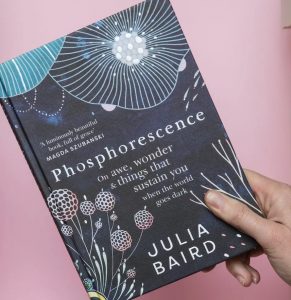 A number of writers and visual artists have encouraged u s to take solace in nature. I was gifted Julia Baird’s book Phosphorescence in 2020. She makes the human need for nature abundantly and eloquently clear: we humans are nourished by our earth. Time spent in nature replenishes our minds and bodies and spirits.
A number of writers and visual artists have encouraged u s to take solace in nature. I was gifted Julia Baird’s book Phosphorescence in 2020. She makes the human need for nature abundantly and eloquently clear: we humans are nourished by our earth. Time spent in nature replenishes our minds and bodies and spirits.
The works of visual artist Shona Wilson and sculptural fibre artist and basket weaver Caroline Hawkins highlight elements in nature which may otherwise be overlooked. Using no tools and only materials which are present in our environment, they make artworks in nature with nature, drawing attention to the ephemeral and creating installations that live in the moment. The by-line of Baird’s Phosphorescence reads on awe, wonder & things that sustain you when the world goes dark. This could also describe the effect of Wilson’s and Hawkins’ work.
Magda Szubanski believes Phosphorescence to be a luminously beautiful book, full of grace. So is Wilson’s book One A Day. In explaining her project, Shona Wilson writes: This book is the tangible archive of a year exploring and creating ephemeral sculptures in response to any given environment I found myself in each day. From car parks to National Parks, this One A Day Ephemeral Art Project revealed to me that there are wonders and treasures to be found and created within any location (SW 2015).
Caroline Hawkins acknowledges an indebtedness to Shona Wilson for her inspirational workshops introducing the ‘no tools’ and ‘only materials which are present’ concept. She brings her own observations, creativity and sensitivities to artworks which highlight elements which may otherwise be overlooked. I was particularly inspired by her response to the beach. Here change is palpable: each wave reforms the sand, shifts seaweed, rolls pebbles and shells; it reveals, exposes, covers and submerges; it leaves traces, carves deeply, erodes and builds.
Hawkins writes, The practice of ephemeral art draws on [a] capacity to observe, the desire to understand, to connect, to be in awe of the beauty of nature and to become aware of its transience. The process of creating a piece can become deeply immersive, requiring full concentration and presence, in order to capture the peak moment, which may be very brief.
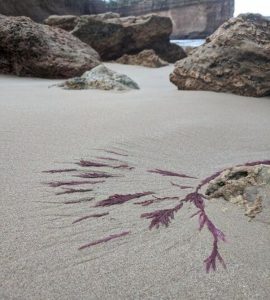

Caroline Hawkins As a wave retreats and the channels it leaves behind …
Being in touch with place, with our presence in place, allowing our senses to be fully embraced, to give ourself over to the present moment, allows us to be at one with the creator God. Hawkins notes that Sand offers a fantastic canvas. It’s not a blank canvas however. Finding marks in the sand left by creatures or retreating flows of water can be the start of a creation. Patterns emerge, are emphasised, marked and shadows reveal. The unlooked for, the unexpected, the discarded are remade or made anew. Wilson and Hawkins exquisitely beautiful works are simple yet profound. They are like a bridge between ourselves and our beautiful country.
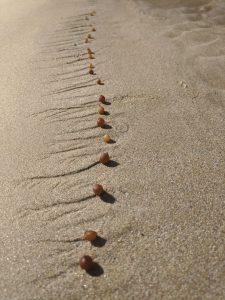
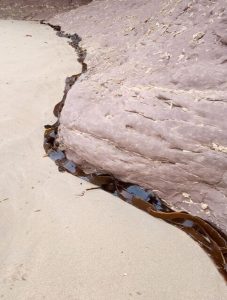
Caroline Hawkins: Sand offers a fantastic canvas. It’s not a blank canvas however.
Finding marks in the sand left by creatures or retreating flows of water can be the start of a creation.
Parallels with our liturgical seasons are palpable. The experiences of the Church seasons are designated ‘seasons of the heart’ by John Gallen sj:
ADVENT: The Experience of Desire
CHRISTMAS: The Experience of Discovery
LENT: The Experience of Rescue
EASTER: The Experience of Transformation
ORDINARY TIME: The Experience of Journey
Ordinary time is the longest season, split into two parts, the shorter between Christmas and Lent and the longer after Easter until Advent begins the Church’s seasonal cycle again. Ordinary Time is a time when we get on with the daily business of living our faith – an even bigger challenge during lockdowns. In Australia, this long ordinary time coincides with the southern hemisphere winter and spring. Green is a sign of life in nature signalling growth and hope. Green is the colour worn most often in Ordinary Time liturgies, symbolising the graces that draw people into the life of God. Nature is God made visible in our everyday lives.


Aboriginal spirituality shows a deep reverence to the earth and is rich in symbolism and prayer. Aboriginal people throughout Australia have different sets of beliefs and rituals, but all show a respect and an understanding of the sacred land in which we belong. Pope Francis in Laudato Si’ encourages us towards lifestyles that are simpler and more respectful of the environment, to hear the cry of the earth and the cry of the poor which are becoming increasingly serious and alarming, and urges humans to take decisive, urgent action to transform this crisis into an opportunity. Catholic Earthcare Australia’s mission is to promote understanding among people that Creation is sacred and endangered, that it needs to be protected and sustained for present and future generations yet unborn. Caroline Hawkins’ work invites us to look, to see, to reflect and to create. The gift of the ephemeral acknowledges the fragility and the wonder of God’s creation here on earth.
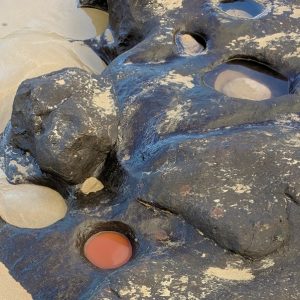
Architectural historian, Dr Ursula de Jong, is Honorary Associate Professor in the School of Architecture and Built Environment at Deakin University, Geelong.
